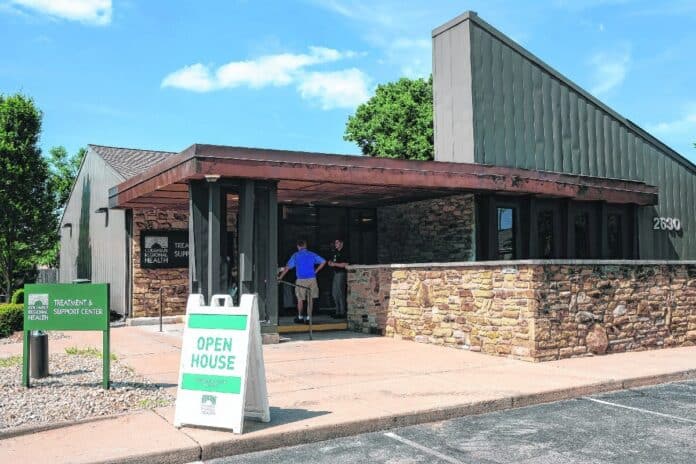
Columbus Regional Health’s Treatment and Support Center (TASC) is facing a new set of challenges one year after opening as staff attempt to counter a rise in fatal drug overdoses in the community and a surge in relapses amid a pandemic threatening to deepen the nation’s drug crisis.
The treatment center, at 2630 22nd St., which opened in July 2019, has seen higher-than-anticipated demand for outpatient drug treatment fueled by an epidemic of addiction to painkillers, heroin, methamphetamine and other substances that had swept into Bartholomew County, resulting in at least 90 fatal drug overdoses since 2017, including at least 19 so far this year.
TASC saw 596 unique patients from July 1 to June 16, far surpassing CRH’s initial projections of around 200 to 250 patients and matching the five-year projection of 600 patients.
The pandemic, however, has taken “an enormous toll” on the treatment center and its patients, said Dr. Kevin Terrell, TASC medical director.
[sc:text-divider text-divider-title=”Story continues below gallery” ]Click here to purchase photos from this gallery
While Terrell said he could not directly attribute the increase in local overdose deaths to TASC and other services not being fully accessible during the pandemic, he said there could be “some correlation” and “could have led to some overdose deaths.”
One particular concern that many health experts across the country have voiced, including in Bartholomew County, is that the desperation and stress caused by the pandemic — including extended isolation due to staying at home and being laid off from jobs — could exacerbate many of the destructive habits and lead to surge in relapses, potentially with fatal consequences.
“My guess is that the number of people (at TASC) who have relapsed has doubled or tripled,” Terrell said. “It has been an enormous spike, and those are just the ones who admitted to having a relapse.”
Currently, TASC is in the process of gradually bringing patients into the treatment center more frequently, including for socially distanced group therapy sessions, after the outbreak of COVID-19 in the community forced the treatment center to temporarily shut its doors in mid-March and shift many of its services online or over the phone.
Because most patients weren’t being seen in person, TASC officials have had to rely on an honor system of sorts for checking patients for relapses because they have not been able to screen their urine for drugs, Terrell said.
“If they don’t tell us, we don’t know,” he said, referring to patients who have relapsed. “There are probably not only a number of people who have admitted to relapse but there are a huge number, a larger number who have used a substance and haven’t told us about it.”
“That’s one of our motivations of getting people in the office so we can do urine drug tests and also so we can get people out of isolation in some cases so we can address those mental health issues and the toll that isolation takes on people from a mental health and social perspective,” he said.
The challenge of retention
The biggest challenge facing TASC, however, is retention, Terrell said.
Around half of patients seeking treatment at TASC have dropped out of treatment, including around one-third who dropped out within the first month, in what Terrell characterized “the first fragile weeks.”
“We’ve had 596 come in, and we have around 280 active clients,” Terrell said. “About 50% have remained in treatment, and 50% have left. Now, some of them have moved out of the area, but sometimes they just leave because they don’t want treatment or maybe they have a relapse and just end up just falling out of treatment. Our biggest measure of success is that they keep coming back for treatment.”
In response, TASC has stepped up efforts to increase retention during the first weeks when CRH officials believe people are most likely to drop out, including attempting to get patients face-to-face with Terrell or other staff within two to three days, and reaching out to people more frequently if they miss appointments.
“The other thing that we’re going to start implementing in the very near future is a outreach that occurs after people drop out,” Terrell said. “Let’s say someone has dropped out of treatment, meaning that they’ve missed their last week or two of appointments. What we’ve traditionally done is to call them a couple of times to re-engage and get them back in with us. …But what we’re going to start doing is reach out to those people at the three month mark and the six month mark after they drop out of treatment to try to re-engage them.”
The largest sources of referrals to TASC include community corrections, CRH’s VIMCare and some local obstetrician/gynocologists, Terrell said.
Shifting trends
Even before the coronavirus pandemic struck, Terrell and his staff were already starting to notice a shift in the most common substances that people were seeking help for, particularly for methamphetamine and a class of drugs known as benzodiazepines.
Fentanyl, a powerful synthetic opioid, also has been showing up in unexpected places, with many patients who thought they were using heroin later discovering via urine screenings that they were actually using fentanyl, Terrell said. There have also been cases of patients who thought they were just using methamphetamine but were really using methamphetamine laced with fentanyl.
The most common scenario at TASC, Terrell said, are people struggling with both methamphetamine and opioids.
“We’re seeing fewer people with pain pill problems,” he said. “We’re still seeing a lot of it, but we’re seeing much more methamphetamine than we did when we first opened and maybe a little bit less heroin.”
“The truth is that people may use a substance and be told that it’s one thing but truly have no idea what they’re putting into their bodies,” he said. “It’s really a pretty scary situation.”
The most common substances that pregnant patients are struggling with are opioids, typically heroin, Terrell said. Most pregnant patients at TASC are being treated with suboxone, a medication that is used to treat opioid addiction.
“I’m probably overestimating, but we get somewhere around a referral a week for a pregnant woman,” he said “…We’ve had five or six women, maybe more, who have delivered their babies when we’ve been taking care of the mom and they’ve done that at CRH. None of them have had any complications from being on suboxone. Occasionally, the baby will have some withdrawal symptoms, but the hospital is very good at managing those in the nursery.”
TASC has also seen an increase in the number of people seeking help for addiction to benzodiazepines, which are tranquilizers prescribed for anxiety and other medical conditions, Terrell said. Common benzodiazepines include Xanax, Klonopin and Ativan.
Terrell suspects that some doctors may be prescribing benzodiazepines to people struggling with opioid addictions to treat withdrawal-related anxiety.
However, withdrawal from benzodiazepines can cause seizures and other medical conditions, and the weening process can take eight to 12 weeks and require hospitalization, Terrell said.
“Unfortunately, the opioid epidemic, from a pain pill perspective, in some ways is transitioning from opioid prescribing into benzodiazepine prescribing by providers, he said. “…They’re much more dangerous to take people off of than opioids are.”
Telemedicine
Over the next year, Terrell said he hopes TASC will double the number of patients seen to around 1,200 and increase telehealth to make it easier for patients who don’t live near the treatment facility to remain in treatment.
“We’ve really changed our way of doing business,” Terrell said. “(Due to the pandemic) we all had to become very comfortable with telehealth. I want our practice to continue to leverage telehealth because we are seeing a number of patients from surrounding counties. I have patients in Jackson County, I have a number of patients who live in Brown County, as well as Decatur County.”
One of the deliverables of a $1.5 million grant TASC received from the Substance Abuse and Mental Health Services Administration in February 2019 includes partnering with five health care sites in surrounding counties to deliver telehealth services by the end of January, Terrell said.
The partnerships would allow patients to take urine tests and other medical exams at a health care facility or county health department closer to where they live and attend telehealth sessions with TASC staff at the partnered facilities.
“That would allow patients to stay closer to home and for us to still be able to get vital signs on them and for us to still be able to get urine drug screens on them, but they don’t have to drive all the way to Columbus if they live in a remote part of Brown County, for instance,” Terrell said.
Currently, TASC has not yet reached any agreements with any facilities to provide telehealth services, Terrell said.
[sc:pullout-title pullout-title=”Where to learn more” ][sc:pullout-text-begin]
Columbus Regional Health’s Treatment and Support Center (TASC) provides a range of outpatient treatments for substance abuse disorders, including medication-assisted treatment in certain cases, according to the treatment center’s website.
Medication-assisted treatment is the combination of medications approved by the U.S. Food and Drug Administration and counseling and cognitive behavioral therapy, including individual or group counseling, family therapy or referrals to other services in the community, according to the National Institute on Drug Abuse.
Visit www.crh.org/physician-practices/treatment-and-support-center to learn more.
[sc:pullout-text-end]




